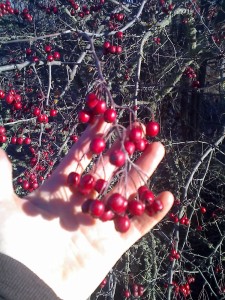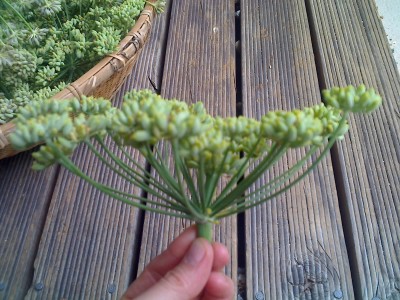This post is part of the UK Herbarium June Blog Party My Favourite Tree Medicines, kindly hosted by Lucinda at Whispering Earth.
I think I might be in love.
I picked some hawthorns at Easter and set them out to dry. In the past week I’ve been experimenting with water based preparations to find the best way to use the dried berries. I’ve been using hawthorn berry tincture for a few years, off and on, but had never worked with the dried berries.
At Easter I also started an experiment to see if I could make fruit leather, but the resultant mash (fresh berries simmered in minimal water long and slow, and then pressed through a sieve) was so unappetising that I froze it until I can figure out what to do with it. Hawthorn berry tincture has such a delightful taste that I was sure the fruit leather would be a go if I could get it to dry properly. The berries themselves are pleasant enough tasting especially now that they’ve had a few frosts to sweeten them up, but there must be something about heat that changes the taste.
So I was curious to see what would happen with my newly dried berries. First I made some tea – a tablespoon of berries steeped in a cup of just boiled water for 20 or 30 minutes. The result was pale, bland and not particularly inspiring. The berries are very hard when dried, so I figured they needed more heat to cause the cell walls to break and release all the goodies. A few more experiments and I’ve settled on this:
Hawthorn decoction
1. put 3 tablespoons/30gm hawthorn berries in a suitable pot (I use an old coffee pot because it’s easy to pour from).
2. add 500 ml cold water and put on the lid.
3. put on a slow heat and bring to a simmer. Don’t boil, as this will release the more bitter flavours and probably destroy some of the vitamins.
4. simmer for as long as you like, or can wait – 30 minutes is fine but I’ve left it on a very slow heat for an hour or more.
5. drink as is, or allow to infuse in the pot for as long as it takes you to use it up. I’m currently making 4 cups at a time and letting it infuse for several days before the last cup is drunk.
This brew is rich, oily and satisfying*. It has an initial distinct sweetness, quickly followed by the kind of tartness that is associated with vitamin C (similar to its cousin the rosehips). There are undertones of bitter.
* I’ve just looked this up and it’s not oily so much as soapy – hawthorn berries contain saponins, chemicals that make things slippery.
Harvesting and Drying
One of the things I love about hawthorn is that it is so abundant. Both in terms of berries on the tree, and trees in the landscape.
This is a herb that we can harvest with relative ease and in many places there is so much hawthorn we can harvest large amounts. This is necessary for making nourishing type infusions that use a lot of herb to brew. But it’s also reminds us that even in the depths of winter the land has much to offer. Hawthorn often grows on land where not much else does well, giving us a gnarly nourishment. Because of its abundance and ability to grow in marginal places and because it offers strong but safe medicine as well as nutrition, I consider it one of our important wild plants in terms of powerdown and transition to a post-oil life. Hawthorn will of course also grow happily in a garden, and is a common tree in hedgerows in the UK – there are hedges of hawthorn in NZ, but I’m not sure if it’s used in mix hedgerows much here.
For harvesting the berries, I take a basket and a pair of scissors or garden snips. At this time of year there are no leaves and so the berries are easier to take off the branches. You can usually snap off a cluster from its branch, sometimes I use the snips.
At home I then cut the berries off the small stalks. I think the stalks are fine to be used in the decoction, but the berries will dry better if not in clusters. You can cut the berries off easily in bunches, being careful to not cut the berries themselves. I then lay them in a single layer on a cane tray to dry, giving the tray a shuffle once a day or so to turn the berries and make sure they dry evenly.
You could also leave the berries in their clusters and hang them over a line. Either way they need to be somewhere warm and dry.
The last batch seemed to take a long time to dry – more than a month. The berries have a dry-ish texture so I wonder if it’s the thickness of the skin that makes them take a while to dry. The current batch are bigger than last time, presumably because we’ve had so much rain. I’ve weighed them to see how much water has evaporated once they have dried.
I’m drinking hawthorn because the taste is lovely and because I want a warming digestive* breakfast drink on these cold winter mornings. I find the brew relaxing, almost sedative, having a general feeling of opening. I’m also happy that the decoction will be yielding significant amounts of vitamins, minerals and other nutrients including bioflavonoids. And I like that hawthorn is a safe heart tonic, so it will be promoting good heart health in my middle years.
* that’s the sour and bitter tastes.
Resources
More things to do with hawthorn berries.
HerbTV’s video on Valentine’s Day herbs has some excellent information on hawthorn as medicine (US hawthorns look a bit different to ours, but are interchangeable medicinally and for food).
















